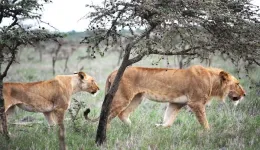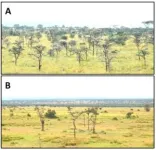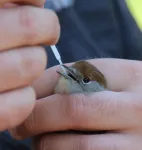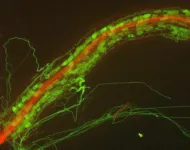(Press-News.org) What makes the little old ant think he can disrupt the life of an African lion?
Researchers say it’s more than just high hopes.
In a study published today in the journal Science, a team of scientists reports that a tiny and seemingly innocuous invasive ant species is changing tree cover in an East African wildlife area, making it harder for lions, the world’s most iconic predator, to hunt its preferred prey, zebra.
“These tiny invaders are cryptically pulling on the ties that bind an African ecosystem together, determining who is eaten and where,” said Todd Palmer, an ecologist and professor in the Department of Biology at the University of Florida.
The study, which spans research over three decades, comprised a combination of hidden camera traps, collared lions tracked by satellites and statistical modeling. It illustrates the complex web of interactions among ants, trees, elephants, lions, zebras and buffaloes.
The disruption begins in the acacia trees in the Ol Pejeta Nature Conservancy, an African wildlife area in central Kenya. The trees are historically protected from leaf-eating animals by a species of ant that nests in the trees’ bulbous thorns. In return for their home, the ants ferociously defend the trees from gigantic plant eaters, like elephants, giraffes and other herbivores — an arrangement ecologists call mutualism.
In published studies from the early 2000s, Palmer began to unravel the complexities of this congenial relationship in East Africa between plant and animal species.
“Much to our surprise, we found that these little ants serve as incredibly strong defenders and were essentially stabilizing the tree cover in these landscapes, making it possible for the acacia trees to persist in a place with so many big plant-eating mammals,” Palmer said.
In the latest study, however, scientists say the arrival of an invasive insect known as the “big-headed” ant (Pheidole megacephala) is setting off a chain of events that has resulted in a shift in predator-prey behavior that may further jeopardize populations of lions — a species already on the brink of endangerment.
The big-headed ants are small but voracious hunters of insects, destroying colonies of the tree-protecting ants but not defending the trees from the larger animals. Having lost their bodyguards, the acacia trees are being obliterated by elephants. The lions, which are ambush predators, rely on the tree cover to stalk and hide before pouncing on zebras. Less tree cover means lions are not as successful at ambushing their prey.
“Oftentimes, we find it’s the little things that rule the world,” Palmer said. "These tiny invasive ants showed up maybe 15 years ago, and none of us noticed because they aren’t aggressive toward big critters, including people. We now see they are transforming landscapes in very subtle ways but with devastating effects.”
Making the best out of a bad situation, the lions are turning their attention to buffaloes, Palmer said. However, buffaloes are larger than zebras and hang out in groups, making them much more formidable prey.
“Nature is clever, and critters like lions tend to find solutions to the problems they face,” he said, “but we don’t yet know what could result from this profound switch in the lions’ hunting strategy. We are keenly interested in following up on this story."
The field work in Kenya was led by University of Wyoming doctoral candidate and Kenyan scientist Douglas Kamaru. Palmer, along with Jake Goheen, from the University of Wyoming, and Corinna Riginos, with The Nature Conservancy, were co-principal investigators on the National Science Foundation grant that funded the work. In addition to studying the phenomenon, the researchers say they also are interested in finding solutions to halt the loss of tree cover in these iconic landscapes.
“These ants are everywhere, especially in the tropics and subtropics. You can find them in your backyard in Florida, and it’s people who are moving them around,” Palmer said. “We are working with land managers to investigate interventions, including temporarily fencing out large herbivores, to minimize the impact of ant invaders on tree populations.”
As science continues to move toward highly advanced technologies like AI-powered data collection, Palmer said their group’s persistent focus on Kenyan wildlife has involved traditional methods over several decades, showing the staying power of boots-on-the-ground research.
“There are a lot of new tools involving big data approaches and artificial intelligence that are available today,” he said, “but this study was born of driving around in Land Rovers in the mud for 30 years.”
-30-
END
The spread of West Nile virus in Europe is strongly linked to agricultural activities, urbanization, and bird migration, according to a modelling study published January 25, 2024 in the open-access journal PLOS Pathogens by Lu Lu from the University of Edinburgh, UK, and collaborators belonging to a large European collaborative consortium under the VEO (Versatile Emerging infectious disease Observatory) project.
West Nile virus outbreaks have occurred in birds (the natural hosts and reservoirs for the virus), livestock, and ...
The intricate dance of nature often unfolds in mysterious ways, hidden from the naked eye. At the heart of this enigmatic tango lies a vital partnership: the symbiosis between plants and a type of fungi known as arbuscular mycorrhizal (AM) fungi. New groundbreaking research, recently published in the journal Science, delves into this partnership, revealing key insights that deepen our understanding of plant-AM fungi interactions and could lead to advances in sustainable agriculture.
AM fungi live within plant root cells, forming a unique alliance with ...
Jennifer Lippincott-Schwartz, a senior group leader at HHMI's Janelia Research Campus and head of Janelia’s 4D Cellular Physiology research area, has been awarded the 2023 Dickson Prize in Science from Carnegie Mellon University for her pioneering work in live-cell imaging and organelle dynamics.
The Dickson Prize in Science recognizes substantial achievements or sustained progress in the fields of the natural sciences, engineering, computer science, or mathematics. It has been awarded annually since 1970.
Lippincott-Schwartz was recognized for her decades of work in cell biology, including the development of groundbreaking ...
A new study has found that children growing up in low-income families have fewer opportunities to make friends and to socially integrate at school. Researchers from the University of Zurich and the University of Stockholm examined data from over 200 school classes in Sweden and reached this conclusion.
Having friends at school is important for adolescents’ development and it shapes their social skills later in life. Teenagers who feel well integrated in their school class have better mental health and higher grades – which has a knock-on effect on their later careers.
A study led by the University of Zurich set out to examine whether parental income influences ...
Surgeons and scientists at UCLA Health will present data on the latest basic science, translational and health services research that has the potential to improve patient care at the 19th annual Academic Surgical (ASC) Congress in Washington, D.C., Feb. 6 to 8.
The annual meeting, which is the joint meeting of the Association for Academic Surgery and the Society of University Surgeons, will feature nearly 80 abstracts from UCLA investigators that highlight topics in subspecialties ranging from oncology, trauma surgery to cardiothoracic surgery.
Dr. Timothy Donahue, chief of surgical oncology and professor of surgery at the David Geffen School of Medicine, is the current ...
Diagnosis of sepsis in children has been improved based on new research findings. An international research team co-led by the Luregn Schlapbach from the University and the University Children’s Hospital Zurich harnessed artificial intelligence to analyze data from over 3.5 million children suffering from this life-threatening disease.
Sepsis is a life-threatening infection that can lead to organ failure. Every year, around 3 million children worldwide die of the disease. Of those who survive a sepsis infection, every third child suffers long-term consequences, sometimes severe. Until now, there were no evidence-based criteria for diagnosing sepsis ...
WEST LAFAYETTE, Ind. – The Purdue Innovates Office of Technology Commercialization has issued a worldwide, exclusive license for a short-stature corn inbred called D16 to Romney-based Ag Alumni Seed.
The license is limited to popcorn and doesn’t apply to dent corn, field corn or sweet corn.
Traditional breeding techniques
Ag Alumni Seed has supported multiple research projects at Purdue University with both financial and in-kind contributions—such as the use of land, equipment and facilities. Jay Hulbert, the company’s president and CEO, said development of D16 began with research that Guri Johal conducted at the company’s ...
The American College of Cardiology’s Cardiovascular Summit (CV Summit) will take place on February 1-3 in Washington, DC. Bringing together all members of the CV team, the educational event highlights best practices for creating a more efficient, effective and equitable health care system.
As health care systems continue to evolve, CV teams must be equipped to address these emerging trends and changes in operations, economics and the workforce. This year’s CV Summit will feature an array of educational sessions for clinicians, administrators and executives that encompass a multitude of practice models. Participants will learn how ...
Aircraft noise is often a nuisance for people living near airports and in flight paths – and, in the worst case, a health hazard: from sleep disorders to cardiovascular diseases. According to a report by the European Environment Agency, around four million people in Europe were exposed to excessive levels of aircraft noise in 2017. New types of aircraft with a blended wing body (BWB), whose fuselage merges seamlessly into the wings – with less air resistance and lower fuel consumption – are seen as a beacon of hope to alleviate this burden. And with lower noise emissions towards the ground if the engines are mounted on top of the fuselage.
Auralization in the lab
Although ...
HOUSTON ― The University of Texas MD Anderson Cancer Center’s Research Highlights showcases the latest breakthroughs in cancer care, research and prevention. These advances are made possible through seamless collaboration between MD Anderson’s world-leading clinicians and scientists, bringing discoveries from the lab to the clinic and back.
Recent developments at MD Anderson include a combination treatment for KRAS G12C-mutant colorectal cancer; using liquid biopsies to classify small-cell lung cancer subtypes; an artificial intelligence model to improve non-small cell lung cancer classification; ...






